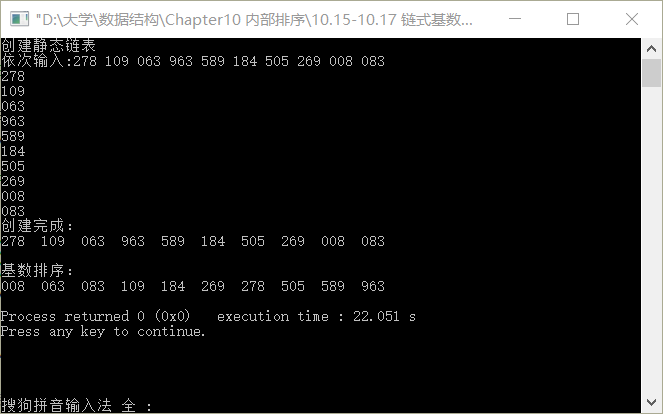溫馨提示×
您好,登錄后才能下訂單哦!
點擊 登錄注冊 即表示同意《億速云用戶服務條款》
您好,登錄后才能下訂單哦!
C語言中怎么實現鏈式基數排序,針對這個問題,這篇文章詳細介紹了相對應的分析和解答,希望可以幫助更多想解決這個問題的小伙伴找到更簡單易行的方法。
C語言中數據結構之鏈式基數排序
實現效果圖:

實例代碼:
#include<stdio.h>
#include<string.h>
#include<stdlib.h>
#define TRUE 1
#define FALSE 0
#define OK 1
#define ERROR 0
#define INFEASIBLE -1
typedef int Status;
typedef int ElemType;
#define MAX_NUM_OF_KEY 8 //關鍵字項數最大值
#define RADIX 10 //關鍵字基數,此時是十進制整數的基數
#define MAX_SPACE 100 //書上為10000
#define ord(ch) ((ch)-'0')
#define succ(x) ((x)+1)
typedef char KeyType;
typedef struct
{
KeyType keys[MAX_NUM_OF_KEY]; //關鍵字
int next;
}SLCell; //靜態鏈表的結點類型
typedef struct
{
SLCell r[MAX_SPACE]; //靜態鏈表的可利用空間,r[0]為頭結點
int keynum; //記錄當前關鍵字個數
int recnum; //靜態鏈表的當前長度
}SLList; //靜態鏈表類型
typedef int ArrType[RADIX]; //指針數組類型
/*******************************聲明部分****************************************/
/*******************************函數部分****************************************/
void Distribute(SLCell r[],int i,ArrType f,ArrType e)
{
int j,p;
for(j = 0;j<RADIX;++j){
f[j] = 0;
e[j] = 0;
}
for(p = r[0].next; p ;p = r[p].next){
j = ord(r[p].keys[i]);
if(!f[j])
f[j] = p;
else
r[e[j]].next = p;
e[j] = p;
}
}
void Collect(SLCell r[],int i,ArrType f,ArrType e)
{
int j,t;
for(j = 0; j<RADIX&&!f[j] ; j = succ(j)); //找到第一個非空子表,succ為求后繼函數
if(j<RADIX){
r[0].next = f[j];
t = e[j];
while(j<RADIX){
for(j = succ(j) ; j<RADIX-1 && !f[j]; j = succ(j));
if(f[j] && j<=RADIX-1){
r[t].next = f[j];
t = e[j];
}
}
r[t].next = 0;
}
}
void RadixSort(SLList *L)
{
int i;
ArrType f,e;
for(i = 0;i<L->keynum;i++){
Distribute(L->r,i,f,e);
Collect(L->r,i,f,e);
}
}
void CreateSLL(SLList *L)
{
char s[100];
int i,n,ct;
L->recnum = 0;
/* printf("請輸入關鍵字個數:\n");
scanf("%d",&L->keynum);
printf("請輸入鏈表長度:\n");
scanf("%d",&n);*/
L->keynum = 3;
n = 10;
printf("依次輸入:278 109 063 963 589 184 505 269 008 083 \n");
for(ct = 0;ct<n;ct++){
// printf("請輸入關鍵字:\n");
scanf("%s",&s);
L->recnum++;
for(i = 0;i<L->keynum;++i)
L->r[L->recnum].keys[L->keynum-1-i] = s[i];
}
for(i = 0;i<L->recnum;++i)
L->r[i].next = i+1;
L->r[L->recnum].next = 0;
}
void TraverseSLL(SLList L)
{
int i,j;
for(i = L.r[0].next; i ;i = L.r[i].next){
for(j = L.keynum-1;j>=0;j--)
printf("%c",L.r[i].keys[j]);
printf(" ");
}
printf("\n");
}
/*******************************主函數部分**************************************/
int main()
{
SLList L;
printf("創建靜態鏈表\n");
CreateSLL(&L);
printf("創建完成:\n");
TraverseSLL(L);
printf("\n基數排序:\n");
RadixSort(&L);
TraverseSLL(L);
return 0;
}關于C語言中怎么實現鏈式基數排序問題的解答就分享到這里了,希望以上內容可以對大家有一定的幫助,如果你還有很多疑惑沒有解開,可以關注億速云行業資訊頻道了解更多相關知識。
免責聲明:本站發布的內容(圖片、視頻和文字)以原創、轉載和分享為主,文章觀點不代表本網站立場,如果涉及侵權請聯系站長郵箱:is@yisu.com進行舉報,并提供相關證據,一經查實,將立刻刪除涉嫌侵權內容。